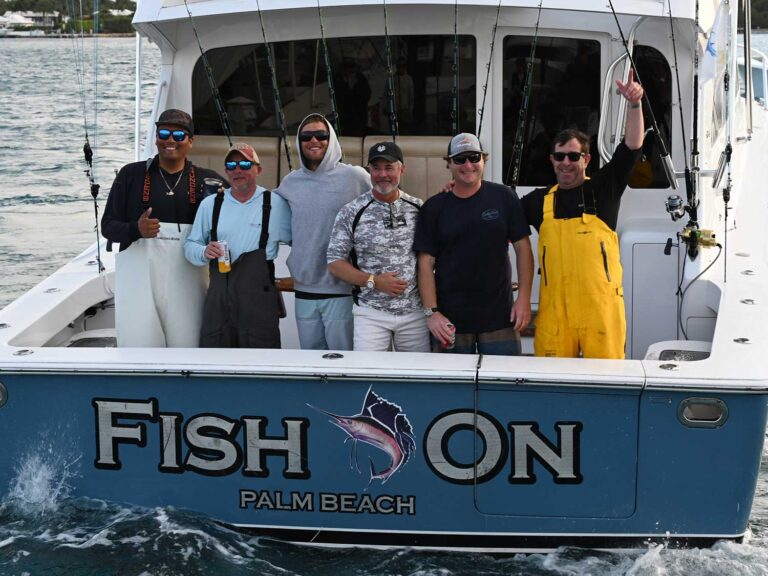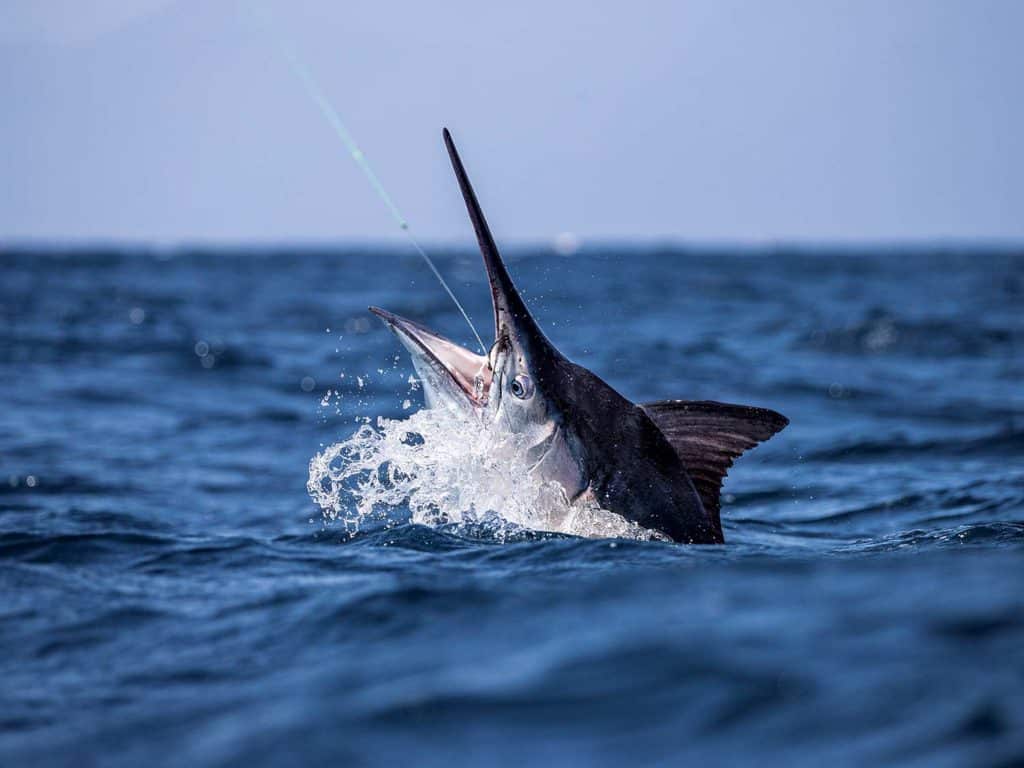
As avid billfish anglers, we pursue our beloved marlin, sailfish and spearfish from the surface—at the intersection between our world and theirs—targeting those that are willing to bite. We troll lures and dead baits, drift live baits, or even kite-fish for them, and so far, it’s worked pretty well, with thousands caught and released every year. While we interact with them at or near the surface, how much time do billfish really spend at said intersection? Your first thought might be just about all the time, but the science might suggest otherwise.
Data collected from pop-up satellite archival tags, or PSATs, reveal temperature and depth residency of these tagged billfish, and the statistics might not be exactly what you’d expect. The IGFA Great Marlin Race works in collaboration with Stanford University and has been tagging billfish for over a decade, with more than 460 tags deployed, and more being added to the database from around the world each year. With a price tag of up to $5,000 each, these sophisticated mini computers are not at all inexpensive, but they can, and do, provide a laundry list of important information that sheds light on what exactly billfish do when nobody is watching.
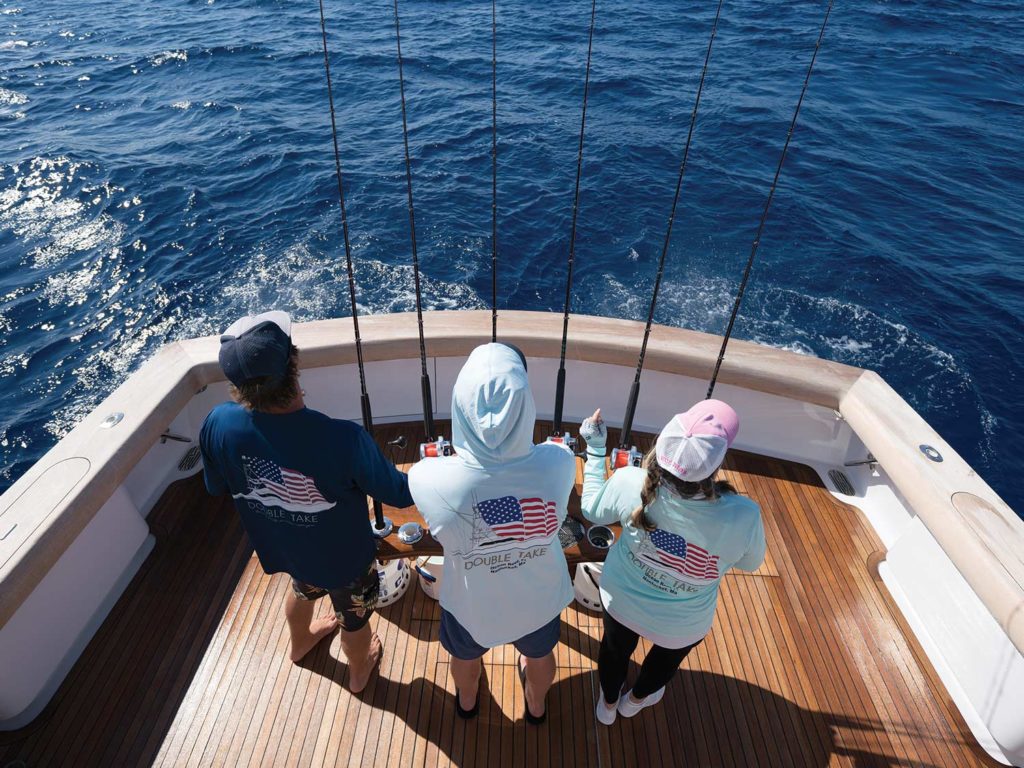
The Ups and Downs
Results from the IGMR have shown the extensive horizontal migrations these fish can make in short periods of time—some up to almost 7,000 nautical miles in 240 days—but we rarely talk about the vertical dimension of billfish behavior from a recreational-fishing perspective. The fact that these fish are typically spread out in the open ocean makes them difficult to study at the surface, let alone study what they do in deeper water.
Before we get into depth preferences and diving profiles, let’s first discuss the daily life of a billfish. During the daytime hours, most billfish species are at their most active. When the sun is high in the sky, marlin and sailfish undergo higher levels of activity and bounce dive to deeper waters. The term “bounce dive” refers to the behavioral pattern where the fish will dive to deeper, colder waters for a short period of time before returning to the surface to repeat the process.
The long-held belief is that these fish could feed at depth and then require some time to warm back up after returning to the surface, given that temperature decreases rapidly with the increase in depth due to the lack of solar energy available to warm it. For example, at depths deeper than about 200 meters, the temperature of the ocean can be close to 40 or 50 degrees Fahrenheit—not exactly the tropical/subtropical surface temperatures in which billfish typically inhabit. The warmth from the sun at the water’s surface is used to overcome the energy expenditure of diving down to feed at depth. Now, how does that impact billfish behavior at night? To answer that question, we first need to consider how billfish can even dive that deep.
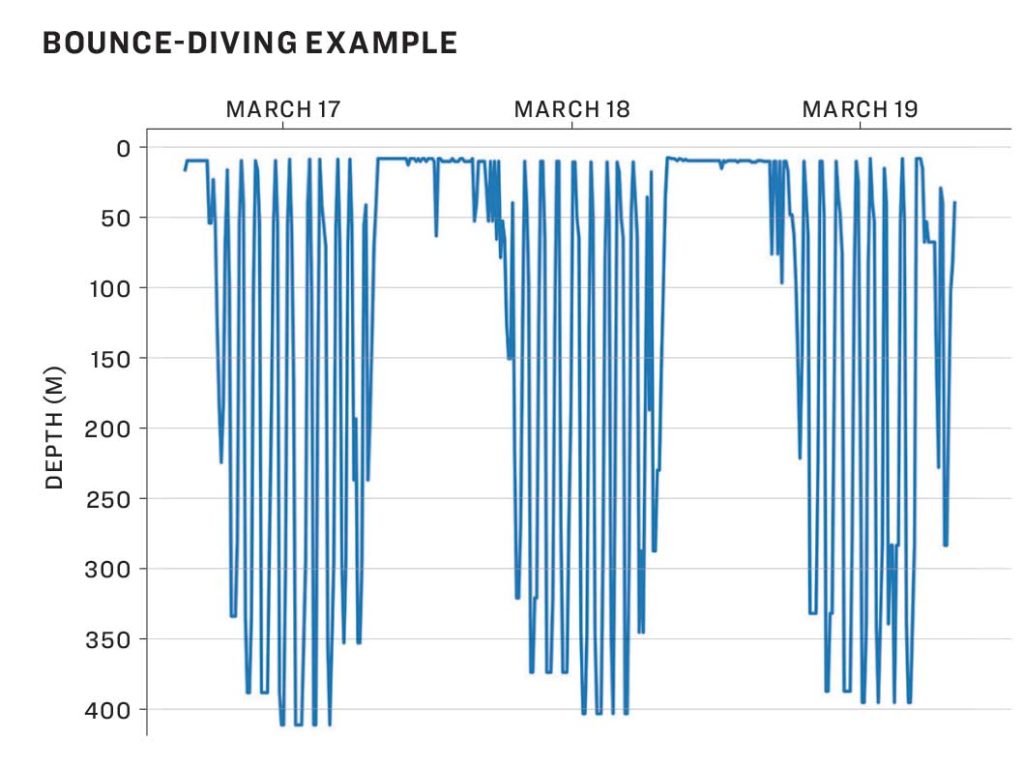
Seeing Things
The primary sense billfish use to find prey is vision. Unlike sharks and other species that have evolved electrophysiological faculties and supreme senses of smell, billfish brains are designed primarily for visual capability. Billfish, along with swordfish and tunas, have evolved to be semi-warm-blooded, and can warm their eyes and brains above ambient water temperatures, giving them an advantage in deeper, colder depths. Because of their physiology, billfish vision is optimized between about 150 meters and 250 meters in clear water—the depth of the interface of dark and light. Their eyes look forward and slightly up, so imagine a billfish swimming at depth with dark water below and more-well-lit water above; this is their evolved prime hunting depth.
So what do they do when there is no sunlight at night? The answer: not much. During the night, billfish activity is low, and data collected on their depth residency reveals that they spend a vast majority of their time in the upper 25 meters of the water column. A study done on sailfish that examined their activity levels using accelerometers showed very little activity at night, except for a slight increase during the illumination of a bright full moon. This result confirmed that light is an important factor in sailfish behavior. Does this mean that we could target sailfish if we employed the powerful lights from a modern football stadium? That remains to be attempted, although some theorize that sails eat at night during the full moon, making daytime fishing during that time a little frustrating in some locations.
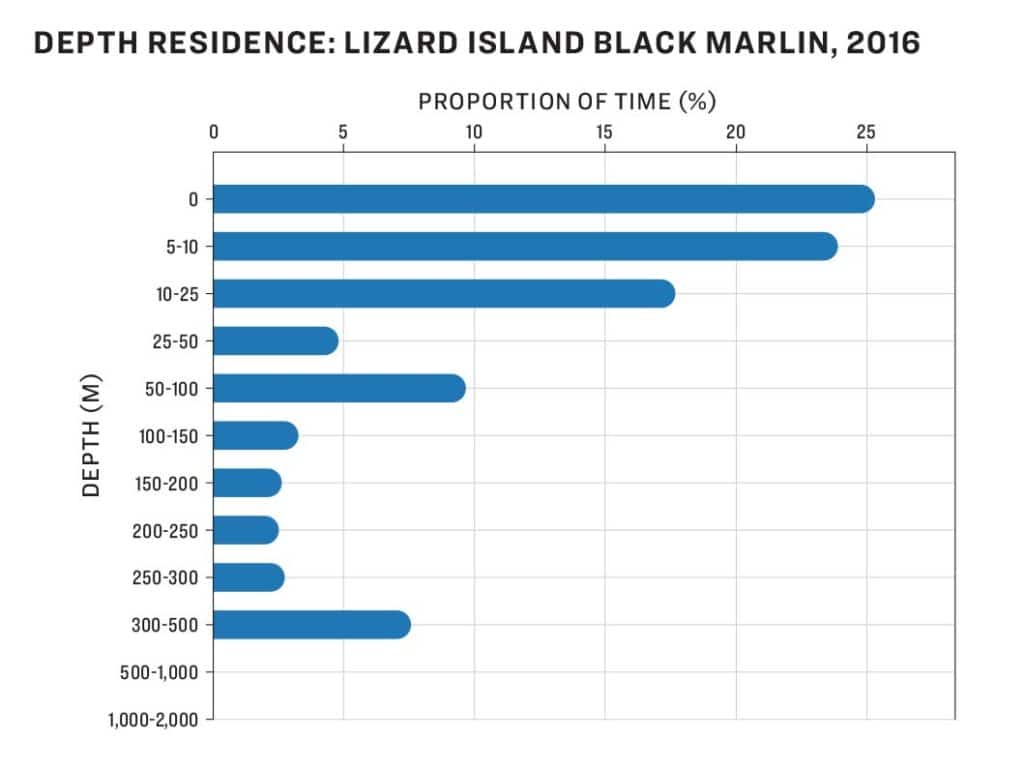
We know that billfish are most active and exhibit more variable diving patterns during the day in an effort to find food items, but does that mean we should troll baits at 150 meters in broad daylight? Probably not. Efficiency is key in the evolutionary world, and a hungry marlin at the surface is not going to turn down a well-placed enticing meal. However, the abundance of prey at depth is sometimes worth the effort to make the swim down, gobble up some prey, and then recover while digesting near the surface. That is not to say that trolling a bonito or plug at depth wouldn’t work; it just might not be worth an angler’s extra effort, and it would certainly be a lot less exciting than seeing a lit-up marlin come into your spread on the surface.
Temperature
To be more specific, data gathered from the IGMR has revealed some impressive statistics on diving behavior of billfish. For example, black marlin regularly dive deeper than 500 meters. One black tagged in October 2016 off Lizard Island, Australia, spent the first month at large in relative shallow depths above the 68-degree temperature layer, then began taking deeper dives to 59 degrees in the second month of the trial, with the deepest dive reaching more than 1,700 feet. In mid-December 2016, this black marlin would dive to 1,578 feet and record the coldest temperature of the trial: 47.5 degrees Fahrenheit. Even though this fish went incredibly deep during its migration, the majority (more than 60 percent) of its residence occurred in depths shallower than 82 feet, remaining in water temps between 78.8 and 86 degrees for nearly 80 percent of the trial.
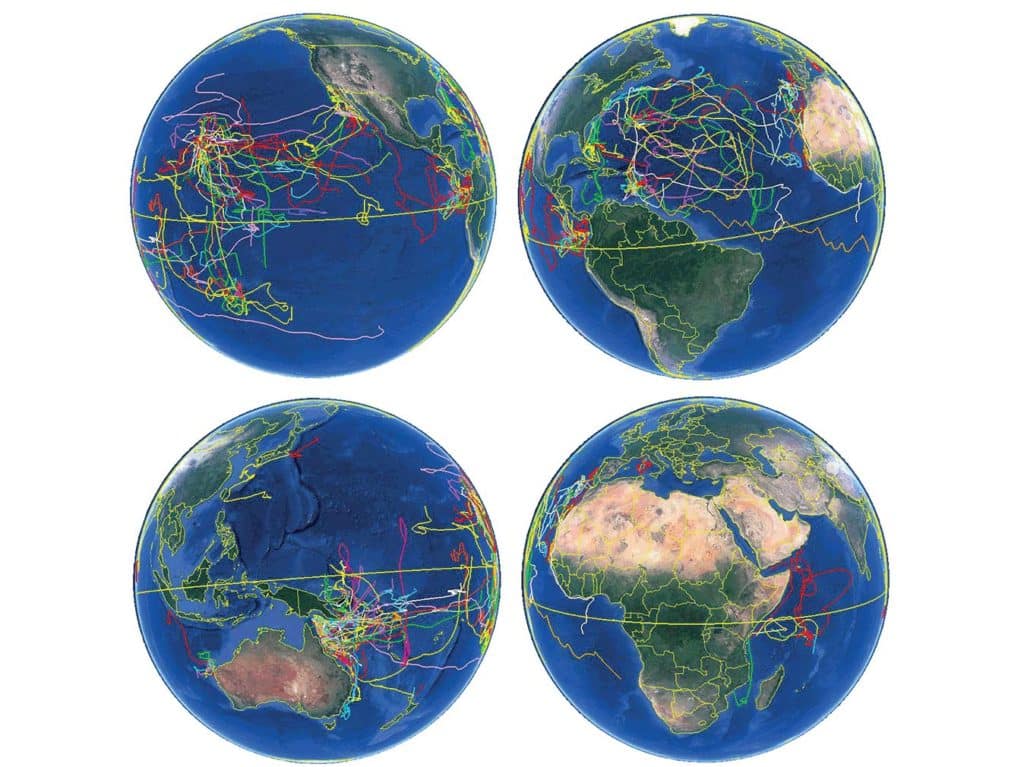
Similar results have been found on blue marlin tagged off Hawaii. One blue tagged off Kona in 2013 reached a maximum depth of 2,336 feet, where the temperature was a little over 42 degrees, but remained at the surface in waters no deeper than 16.4 feet for nearly half of the tagging trial. Both the blue and black marlin consistently showed signs of bounce diving during the day, and we can say the same of striped marlin, white marlin and sailfish. An outlier in these billfish behavioral patterns is the shortbill spearfish.
Unlike marlin and sailfish, shortbill spearfish exhibit a different pattern in diving behavior and temperature preference. In a 2019 publication utilizing IGMR data, researchers examined diving patterns of the shortbill and found a preference for night dives—regardless of lunar phase—as well as a narrow range of preferred temperatures: within 2 degrees of the surface temperature. The nocturnal nature of this species is interesting because their physiology does not differ significantly from other billfishes, however, their diving behavior appears to be directly opposite. Feeding at the surface during the day and at depth at night might open up more opportunity to capitalize on prey that doesn’t overlap with other pelagic species, such as marlin and wahoo, that occupy the same region.
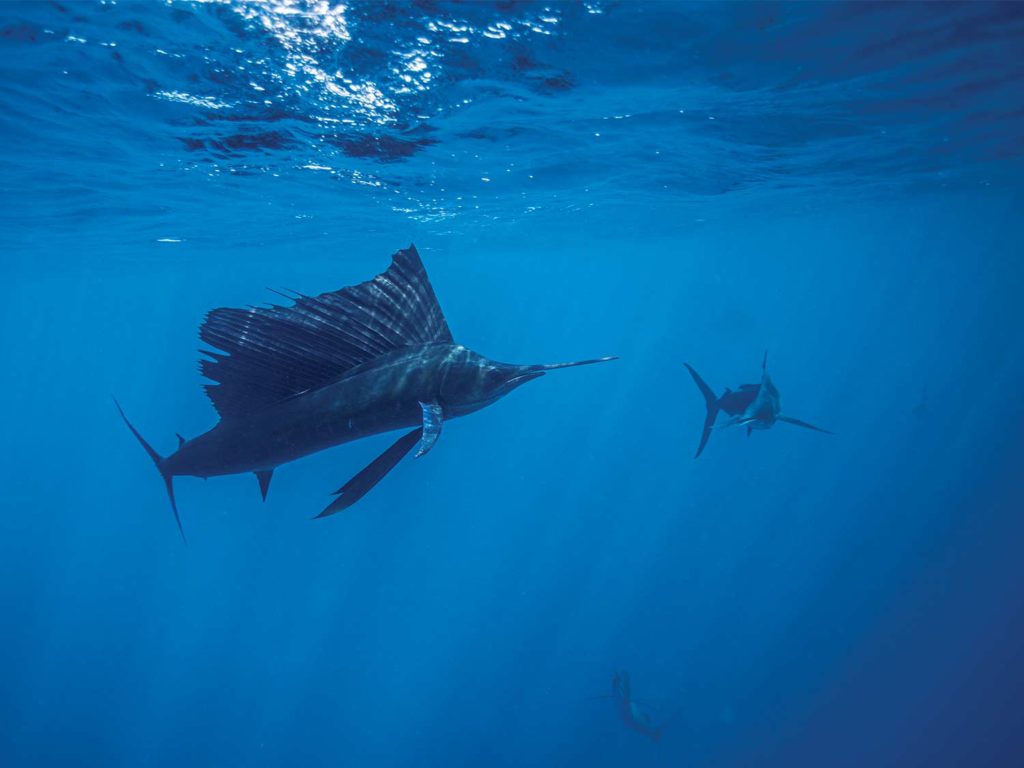
Does Size Matter?
In addition to variations in behavioral patterns among billfish, behavior also differs within a particular species. For example, black marlin diving behavior appears to be linked to their size. A study from Australia published in 2017 examined 102 black marlin equipped with PSATs and found that larger fish were more likely to undertake deeper dives and exhibit typical bounce dives than their smaller counterparts. They found that small black marlin (less than 110 pounds) exhibited patterns more akin to shortbill spearfish, where dives occurred to shallower depths, randomly during both day and night. The authors offer some potential limiting factors to small black marlin diving such as skeletal-muscle performance and lactic-acid buildup, which could limit the smaller fish to those shallower depths. It is possible, however, that ecological factors, such as the depth of appropriately sized prey, also might play a role in the differing diving behavior between fish sizes.
We’ve learned that billfish can live at depth based on the temperatures, so we would assume that sea-surface temperatures do little to dictate migratory movements, but this turns out not to be true. A prime example where temperature does indeed play a role in migratory movements comes from a study published in 2016. This study examined blue marlin movements in the central Pacific by analyzing IGMR tag data from blue marlin tagged off the coast of Hawaii. Researchers found that these blue marlin follow typical bounce-diving patterns during the day and relatively little diving behavior at night; their diving was limited in depths where low levels of dissolved oxygen and/or temperature occurred close to the surface—a phenomenon that scientists call habitat compression. In this case, the diving patterns of these fish were constrained near the surface.
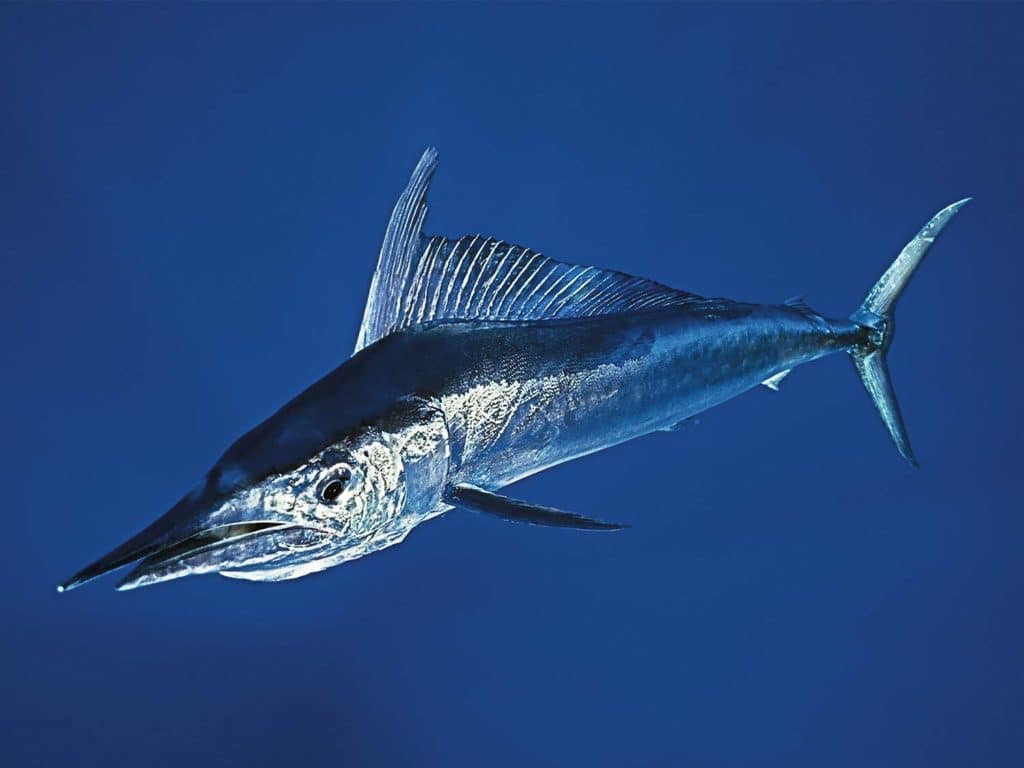
The study also revealed that the horizontal migrations of these fish were affected by temperature as well as available oxygen due to the presence of La Niña during the study. The 2010 La Niña brought increased upwelling along the equator, resulting in both cold sea-surface temperatures and habitat compression, creating a barrier to blue marlin movements. The marlin that typically crossed the equatorial region during non-La Niña years no longer made the journey, preferring to remain in the north central Pacific. In summary, this study found that blue marlin will temporarily inhabit areas with less-than-optimal sea-surface temperatures, as well as reside in areas where habitat compression occurs. However, the combination of the two is a double whammy that blue marlin do not appear to like. The clear avoidance of this cold, low-oxygenated water suggests that the lack of ability to dive can limit horizontal movement as well, which has some rather concerning implications as climate patterns change due to the oceanic and atmospheric phenomena that occur in nature, possibly seeing more compressed habitats moving forward, which is predicted to return to the Northern Hemisphere this winter.
Read Next: Meet IGFA president Jason Schratwieser in our interview.
Effects of Habitat Compression
Many species are affected by habitat compression in the eastern regions of the Atlantic and Pacific. Because of the distribution of oxygen in the world’s oceans, cold, low-oxygenated water upwells along the west African and western Central American coasts. Over the past few decades, the amount of available oxygen at depth has decreased, and the layer of low oxygen has been getting shallower, more so in the Pacific than Atlantic. Imagine a layer of the ocean below that only a few species, such as jellyfish and squids, can inhabit. Along the Pacific coast—from Guatemala to Costa Rica—this layer can be as shallow as 164 feet, effectively cutting off a billfish’s ability to dive to its preferred hunting depth. A study conducted on sailfish off Central America found that their diving behavior mirrored the depth where oxygen levels were too low for the fish to survive.
It is thought that areas of habitat compression actually might be favorable for billfish because it also concentrates their preferred prey in a narrower depth range. This is also a bonus for recreational fishermen because billfish are spending more time near the surface, where they can be more readily targeted by anglers.
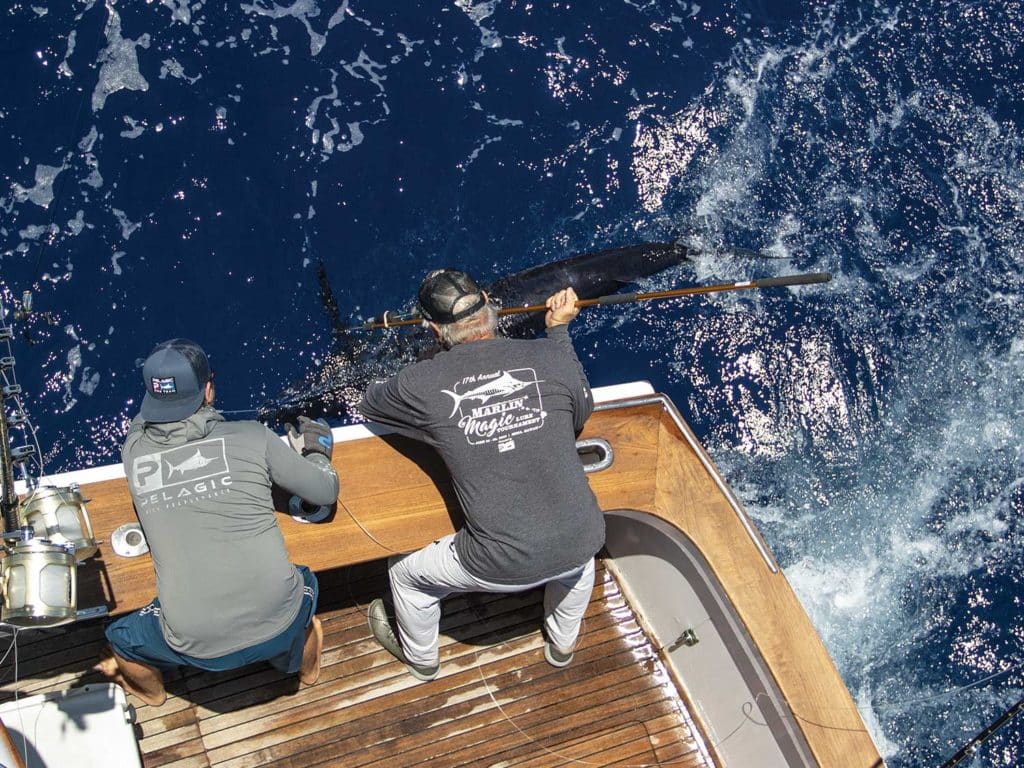
The flip side to this notion is that it also makes billfish more vulnerable to interactions with pelagic longlines, which are responsible for the most billfish mortality worldwide. An important question that arises from this discussion is whether the increased recreational- and commercial-catch rates in compressed habitats are attributable to there being a more abundant billfish stock, or is it because the billfish present in that area are concentrated? This is a question that plagues stock-assessment scientists and might largely preclude us from knowing just how exploited billfish stocks truly are.
Overall, our knowledge of billfish is still in its infancy due to the difficulty and costs of studying this species of fishes. We know very little about many them, especially the lesser-known Mediterranean, longbill, shortbill and roundscale spearfishes. Even the ever-popular black marlin is data-deficient and cannot be assessed to determine the health of the population in most regions.
As science and technology used to study billfish advances, we are learning more about their biology and ecology with each new study. And recreational anglers sponsoring the cost of satellite tags as part of the IGFA Great Marlin Race have been responsible for the majority of findings discussed in this article. Research conducted in new locales and a wider range of billfish sizes will lead to improved knowledge and enhance our ability to manage and conserve these fascinating animals.
This article originally appeared in the February 2022 print issue of Marlin.






